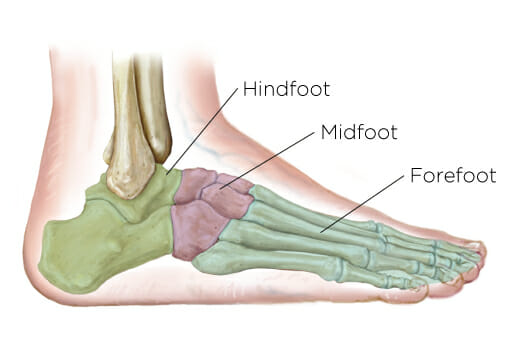

Tarsometatarsal Joint Arthrodesis
What is midfoot arthritis?
Midfoot arthritis occurs when there has been damage to the joint cartilage that normally covers and protects the bones. This results in pain, stiffness, and swelling of the midfoot.
What is an arthrodesis?
The goal of this type of surgery is to glue (fuse) together some of the small joints in the middle of the foot. Pain occurs when an arthritic joint moves. If movement is removed, pain will also be alleviated. Hardware, such as screws and plates, is inserted into the bones to hold the joints together while the fusion occurs. Once the joint is fused, the screws are not necessary, but rarely removed.
What can I expect after surgery?
- Weight-Bearing: You will not put weight on the affected foot for 6 to 8 weeks after surgery (non-weight-bearing).
- Physical Therapy: You will start physical therapy for 6 to 8 weeks after surgery.
- Immobilization: You will be placed into a bulky Jones splint, a soft splint bandage to compress, limit movement, and protect the area after surgery.
What is the typical follow-up appointment schedule after surgery?
- Two Weeks: The bulky Jones splint is removed, and X-rays are completed. Stitches may also come out, but only if the incision is ready for suture removal. You will be placed into a CAM boot. A CAM boot supports the foot and ankle and provides protection after surgery.
- Six to Eight Weeks: X-rays are completed, and the fusion is evaluated to determine how much weight you can place on your foot. If everything looks good, a progressive weight-bearing program is started, which includes transitioning into a normal shoe.
- Three Months: X-rays are completed.
Subtalar and Talonavicular Arthrodesis
What is hindfoot arthritis?
Hindfoot arthritis occurs when there has been damage to the joint cartilage that normally covers and protects the bones. This results in pain, stiffness, and swelling of the hindfoot.
What is an arthrodesis?
The goal of this type of surgery is to glue (fuse) some of the joints of the hindfoot. Pain is elicited when an arthritic joint moves. If movement is removed, pain will also be alleviated. Hardware, such as screws and plates, is inserted into the bones to hold the joints together while the fusion occurs. Once the joint is fused the screws are not necessary, but rarely removed.
What can I expect after surgery?
- Weight-Bearing: You will not put weight on the affected foot for 6 to 8 weeks after surgery (non-weight-bearing).
- Physical Therapy: You will start physical therapy 6 to 8 weeks after surgery.
- Immobilization: You will be placed into a bulky Jones splint, a soft splint bandage to compress, limit movement, and protect the area after surgery.
What is the typical follow-up appointment schedule after surgery?
- Two Weeks: The bulky Jones splint is removed, stitches are removed, and X-rays are completed. You will be placed into a CAM boot. A CAM boot supports the foot and ankle and provides protection after surgery.
- Six Weeks: X-rays are completed and the fusion is evaluated to determine how much weight you can place on your foot. If everything looks good, a progressive weight-bearing program is started, which includes transitioning into a normal shoe.
- Three Months: X-rays are completed.
